Regional election in Lower Saxony, 9 October 2022
Markus Klein
Professor at the Leibniz University of HannoverIssue
Issue #3Auteurs
Markus Klein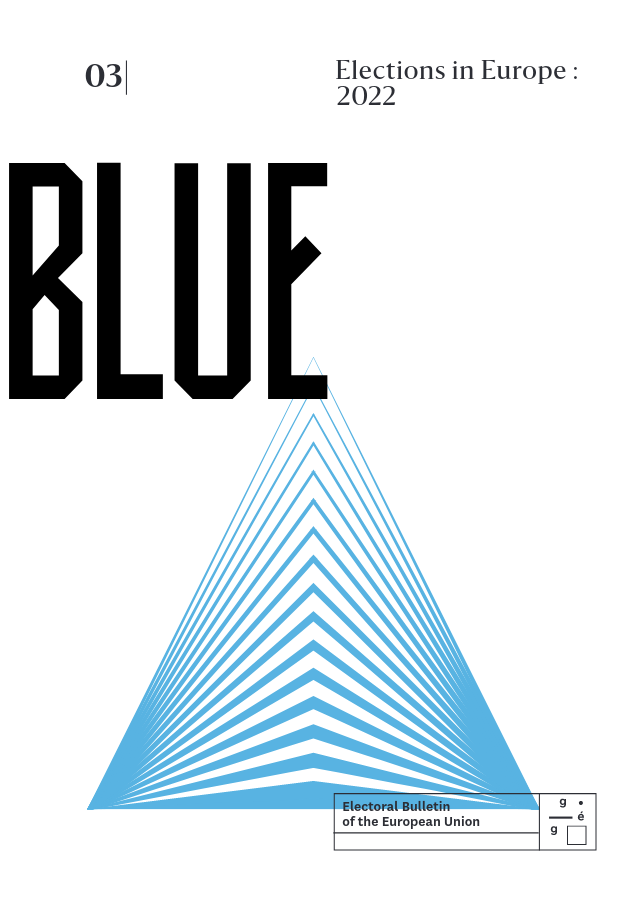
Issue 3, March 2023
Elections in Europe: 2022
The election campaign
The state election in Lower Saxony on 9 October 2022 was the first election in Germany since the reduction of Russian gas supplies to Germany (in stages starting in mid-June 2022) and the attacks on the Nord Stream 1 and 2 pipelines (in late September 2022). The dominant federal political theme in the run-up to this election was the public fear of supply shortages for electricity and gas, as well as concerns about high inflation on the whole and rising energy prices in particular. Although, at the time of the campaign, the federal government had already announced three relief packages and a gas and electricity price cap, there still was a high degree of uncertainty among citizens about the extent of future financial pressures. In addition, an important debate was taking place at the federal level on whether and when the three nuclear power plants still in operation in Germany should be closed. Federal Economics Minister Robert Habeck (Greens/EFA) had decided to put two of the nuclear power plants into reserve mode until the end of March 2023, as well as to shut down the Emsland nuclear power plant, located in Lower Saxony, by the end of the year.
Although all these issues primarily concerned federal politics, they almost completely overshadowed the regional political issues in the state elections in Lower Saxony. The CDU (EPP), FDP (RE) and AfD (ID) all campaigned for the continued use of all three German nuclear power plants, critizing the planned shutdown of the Emsland nuclear power plant in Lower Saxony. The SPD (S&D) and the Greens (Greens/EFA) categorically rejected the continued operation of all nuclear power plants, including and especially the one in Lower Saxony. In addition, the demand for a separate aid package specific to the state of Lower Saxony, which would have further protected the region’s population against the financial burdens caused by the energy crisis, became a central campaign issue. The SPD (S&D) and the Greens (Greens/EFA), in particular, advocated for such a package.
The only regional factor to significantly affect the 2022 Lower Saxony state elections was the personality of the candidates for the office of Minister President. The SPD (S&D) incumbent Stephan Weil was popular among the population and his work was rated positively across party lines (Forschungsgruppe Wahlen 2022a). In the election campaign, he staged himself as a caring “father of the state” (Landesvater) who could lead Lower Saxony through the crisis. This strategy was particularly evident in the SPD’s television election commercial (SPD 2022) and in the overarching campaign claim “The state in good hands”. In contrast, the position of his challenger Bernd Althusmann of the CDU (EPP) was more difficult. As deputy minister-president, Althusmann could not credibly criticise the Grand Coalition’s policies at the state level, as he had been largely involved in their implementation in recent years. He therefore geared his campaign strategy towards turning the state election in Lower Saxony into a protest election against the traffic light coalition of SPD (S&D), FDP (RE) and Greens (Greens/EFA) governing at the federal level. Bernd Althusmann, however, received significantly worse individual ratings from the population than Stephan Weil (Forschungsgruppe Wahlen 2022b). When asked directly about their preference for a minister-president, Stephan Weil was consistently far ahead of Bernd Althusmann in the weeks leading up to the election (Hinford & Neu 2022). The leading candidates of the other parties, on the other hand, played only a minor role in the election campaign. The leading candidate of the Greens (Greens/EFA), Julia Willie Hamburg, and the leading candidate of the FDP (RE), Stefan Birkner, had only a low level of awareness among the population (Infratest dimap 2022). The same was probably true for the second top candidate of the Greens, Christian Meyer, as well as for the top candidate of the AfD (ID), Stefan Marzischewski-Drewes.
The election result
Voter turnout in the 2022 Lower Saxony state election fell slightly compared to 2017 (Figure a). It decreased by 2.8 percentage points from 63.1 per cent to 60.3 per cent. Only in the state elections of 2008 and 2013 had voter turnout been lower. After that, it had risen again slightly due to the emergence of the AfD (ID), which was able to mobilise some former non-voters for itself in the 2017 and 2022 state elections.

State elections in Lower Saxony are conducted according to the system of personalised proportional representation. Voters have two votes. With their first vote, they chose a direct candidate in their constituency, while the second vote determines the distribution of seats among parties in parliament. The SPD (S&D) obtained 33.4 per cent of the second votes in the Lower Saxony state election of 9 October 2022. This corresponded to a decline of 3.5 percentage points compared to the 2017 election. Nevertheless, it remained the strongest force and could therefore be called the winner of the election. The second ruling party in office, the CDU (EPP), also performed worse than in 2017, losing 5.5 percentage points at 28.1 per cent. This was the worst election result for the CDU (EPP) in Lower Saxony since 1955; together, the two governing parties in Lower Saxony lost a total of nine percentage points. Other winners in the 2022 Lower Saxony state elections were the Greens (Greens/EFA) and the AfD (ID). The Greens (Greens/EFA) increased their second vote result from 8.7 to 14.5 per cent, thus achieving the largest absolute increase in vote share among all parties. The AfD (ID), on the other hand, was not able to double its result from 2017, which it had stated as its election goal. After 6.2 per cent in 2017, it nevertheless achieved an increase of 80 per cent with 11.0 per cent in 2022. This was the largest relative gain of all parties represented in the Lower Saxony state parliament to date. In contrast, the FDP (RE) suffered a bitter defeat; after losing 2.8 percentage points in the second votes, it landed at 4.7 per cent just below the 5 per cent threshold laid down in Lower Saxony’s electoral law, and is thus no longer represented in the Lower Saxony State Parliament. The Left Party, which had already failed to enter the State Parliament in 2017, also lost votes and, with 2.7 per cent of the vote, was now even more clearly below the threshold. All other parties running in the State Parliament election were only able to attract marginal shares of the vote. Worth mentioning are the Animal Protection Party with 1.5 per cent of the second votes, the newly founded party dieBasis with 1.0 per cent and the satirical party “Die PARTEI” with 0.9 per cent.
If we look at the regional distribution of the second vote shares of the various parties, we find that the SPD (S&D) has the greatest support among voters in East Frisia, the regions of Hanover and Hildesheim as well as in southern Lower Saxony. The CDU (EPP), on the other hand, is particularly strong in the south-western part of Lower Saxony, especially in the rural districts of Emsland, Cloppenburg and Grafschaft Bentheim. Other areas of support for the CDU (EPP) are in the districts of Rotenburg and Göttingen. The Greens (Greens/EFA) are particularly strong in Lower Saxony’s university towns and the districts bordering them. Finally, the AfD (ID) has its greatest successes in the districts around Wolfsburg, which are strongly influenced by the automotive industry, as well as in the Weser-Ems region in the north-west of Lower Saxony (Figure b).
If we look at the urban-rural divide, it is very clear that the CDU (EPP) and the AfD (ID) do significantly better in the rural areas of Lower Saxony than in the big cities. This is exactly the reverse for the Greens (Greens/EFA). Finally, the SPD (S&D) and the FDP (RE) are roughly equally strong in urban and rural areas.
In Lower Saxony there are a total of 87 constituencies, with a minimum size of the Landtag of 135 seats. Of the 87 direct mandates, the SPD (S&D) won 57. This corresponds to a gain of two mandates. The CDU (EPP) achieved 27 direct mandates, five fewer than in 2017. The Greens (Greens/EFA) were able to win direct mandates for the first time in a state election in Lower Saxony. It achieved this with the constituencies of Lüneburg, Göttingen-City and Hanover-Centre, in three of Lower Saxony’s major university cities.

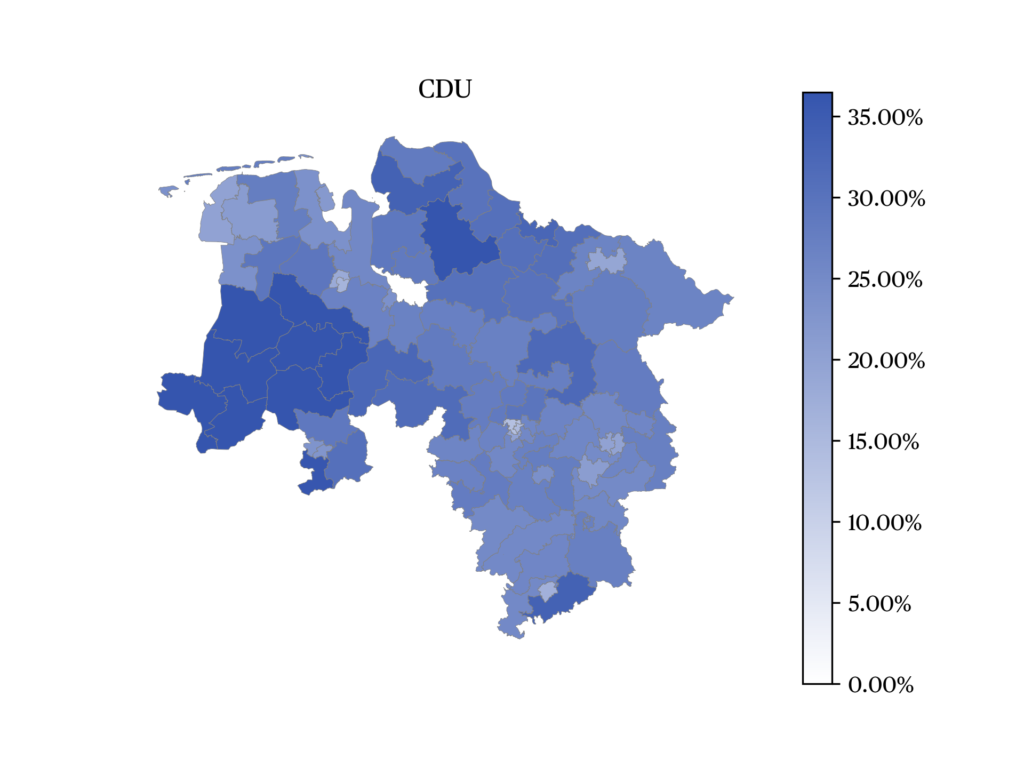
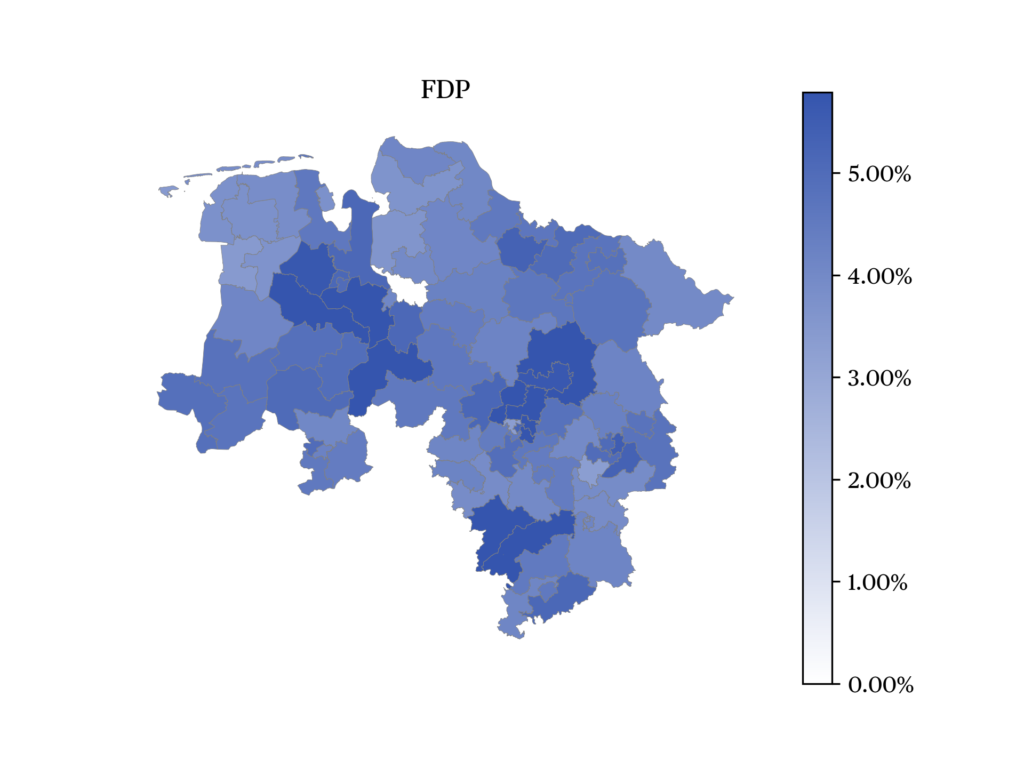
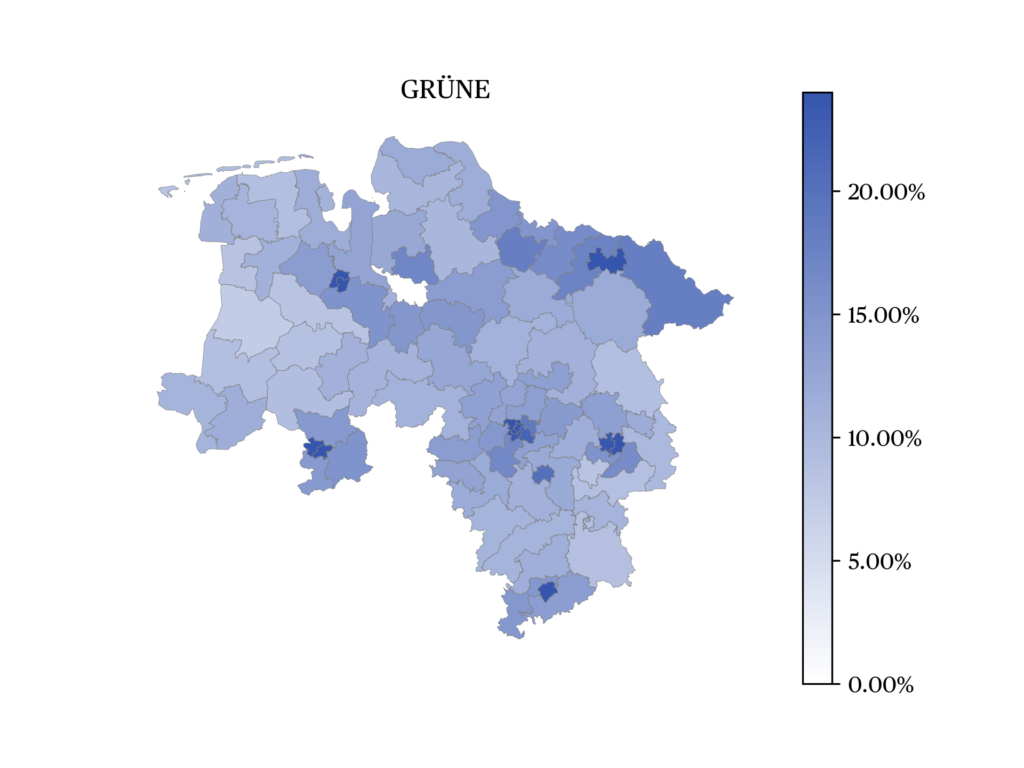
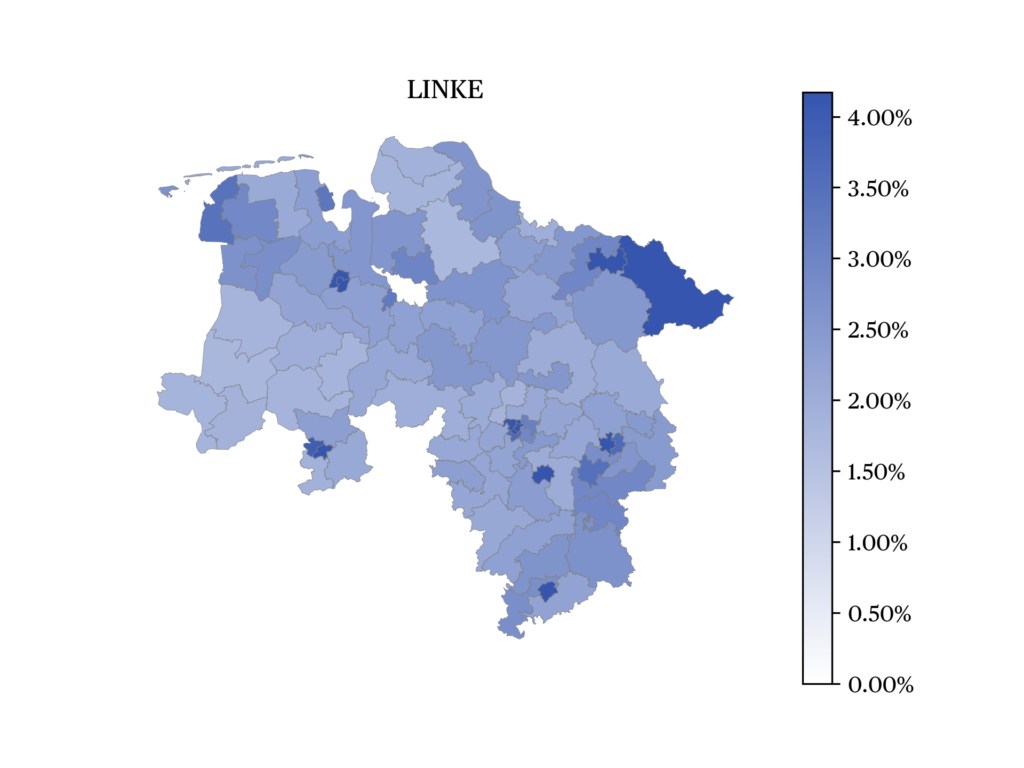

The distribution of mandates
The high number of direct mandates won by the SPD (S&D) had an impact on the size of the Lower Saxony state parliament. When the statutory minimum number of 135 seats was distributed according to the secondary vote result, the SPD (S&D) was entitled to 52 seats. This was five less than the number of direct mandates it won. The number of seats in the Lower Saxony state parliament was therefore increased in two steps by a total of eleven seats, in accordance with the provisions of the Lower Saxony state election law, so that the SPD (S&D) could retain all the direct mandates it had won and the other parties could receive corresponding compensatory seats. As a result, the Lower Saxony state parliament will have 146 seats after the 2022 state election. Compared to the previous legislative period, this is an increase of nine seats. Of the 146 seats, 57 are held by the SPD (S&D), which was able to fill all its Landtag mandates with directly elected MPs. The CDU (EPP) received 47 mandates, the Greens (Greens/EFA) 24 and the AfD (ID) 18. Due to the enlargement of the Landtag and the departure of the FDP (RE), the loss of votes by the SPD (S&D) and CDU (EPP) was only reflected in their mandate numbers in a diminished form. The SPD (S&D) even gained two mandates, although it had lost 3.5 percentage points in the second votes. The CDU (EPP) also only lost three mandates in the end, despite its sizeable losses in the second vote share. The Greens (Greens/EFA) and the AfD (ID), on the other hand, each doubled the number of their mandates. Of the total of 146 members of the Lower Saxony state parliament, 50 are female. The proportion of women is thus 34 per cent. However, the various parliamentary groups in the Lower Saxony state parliament differ significantly with regard to the proportion of women. For example, women make up a majority of 58 per cent in the Greens/EFA parliamentary group, while they only make up 17 per cent in the AfD (ID) parliamentary group.
The formation of a government
The result of the Lower Saxony state election of 2022 would have allowed the continuation of the previous Grand Coalition. However, both the SPD (S&D) and the CDU (EPP) had already made it clear before the election that they would not seek a continuation of the Grand Coalition. The SPD (S&D) declared during the election campaign that it would rather govern with the Greens (Greens/EFA) than with the CDU (EPP). The CDU (EPP) had stated as an election goal that it wanted to become the strongest party so that Bernd Althusmann could become Minister President. The desired coalition partner was officially left open, but one can assume that the CDU (EPP) would have preferred a coalition with the FDP (RE). However, due to the departure of the FDP (RE) from the state parliament and the heavy loss of votes by the CDU (EPP), a government led by Bernd Althusmann was outside the realm of possibility. And so, after the election, there was a new edition of the red-green coalition that had already governed Lower Saxony between 2013 and 2017. SPD (S&D) and Greens (Greens/EFA) together have 81 mandates in the new state parliament, well above the absolute majority of 74 votes. This majority is comfortable enough that a situation like that of 2017 is not to be feared. Back in 2017, the Red-Green Party had governed with only a one-vote majority in the Landtag and a Green MP had switched to the CDU (EPP). This led to early elections, as the red-green state government had lost its majority in parliament.
The state government formed after the state elections is the third cabinet under Minister-President Stephan Weil. The leading candidate of the Greens (Greens/EFA), Julia Willie Hamburg, is the first woman in Lower Saxony’s history to become Deputy Minister-President. She was also appointed as the new Minister of Education and Cultural Affairs and delegated to the Supervisory Board of the Volkswagen Group on behalf of the State of Lower Saxony. In total, the state government comprises ten ministers. Six of these ministers are provided by the SPD (S&D), another four by the Greens (Greens/EFA). Gender parity is established with five male and five female ministers.
Outlook
With regard to state policy, the biggest change in the next few years will probably be that the red-green coalition will move away from the restrictive budgetary policy still pursued under the Grand Coalition at the insistence of the CDU (EPP). At the very least, the coalition agreement plans the creation of a “Lower Saxony Fund”, which can be used to circumvent the so-called debt brake when financing state expenditure. In addition, a “Lower Saxony Green Bond” is to be issued to finance investments in ecological projects outside the regular state budget. The future policy of the red-green state government will focus on climate policy and housing policy. It has been announced that Lower Saxony is to become climate-neutral by 2040 and that, in addition, a non-profit state housing company that has yet to be founded will create 40,000 state-owned flats. In addition, all pupils in Lower Saxony will be provided with a free tablet for use in school.
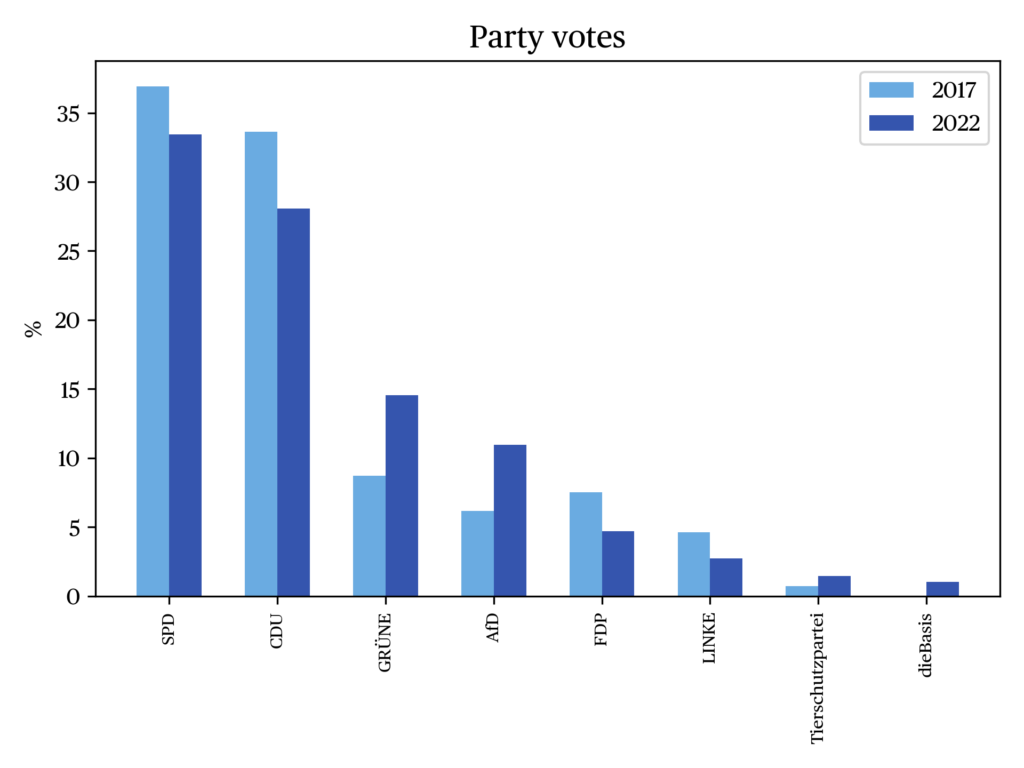
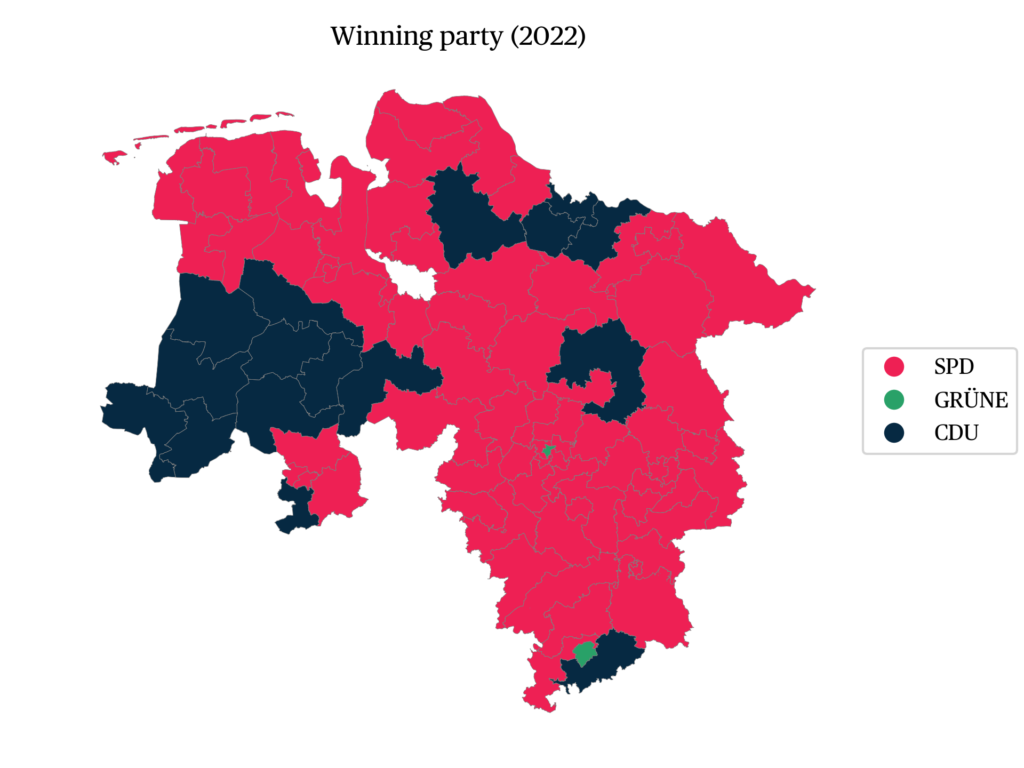
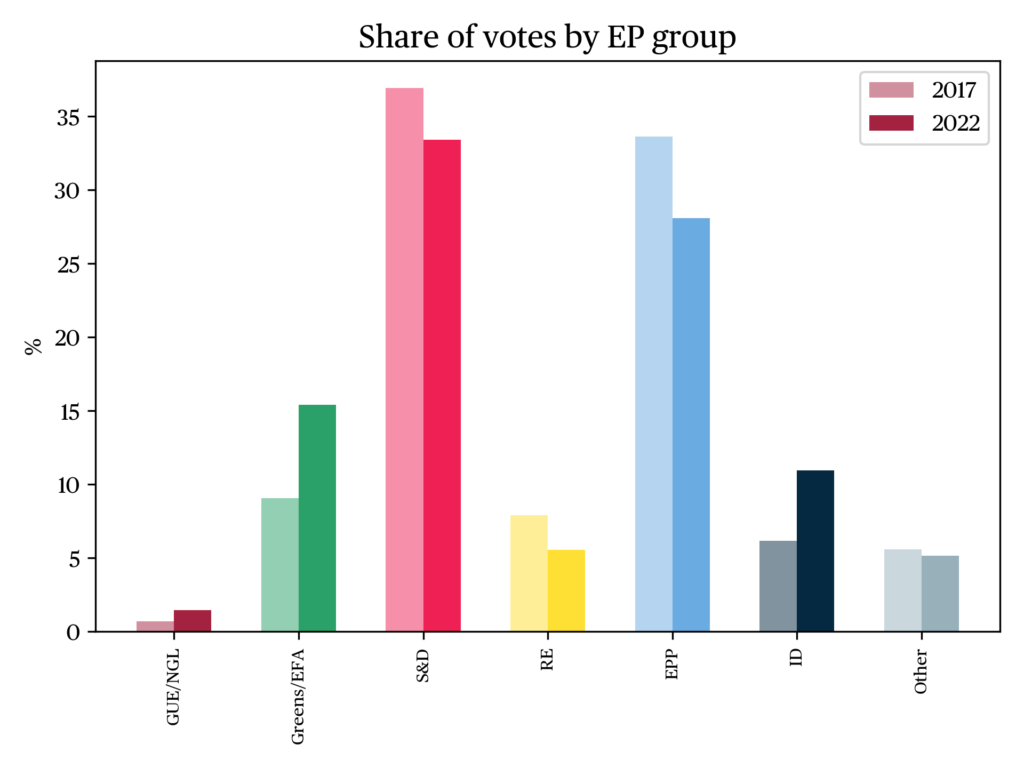

References
Forschungsgruppe Wahlen (2022a). Politbarometer: “Ministerpräsident Stephan Weil macht seine Sache eher…” Retrieved 22.11.2022.
Forschungsgruppe Wahlen (2022b). Politbarometer: “Stephan Weil und Bernd Althusmann. Wer …,” Retrieved 22.11.2022.
Hindorf, D. & Neu, V. (2022). Tabellenanhang zur Landtagswahl in Niedersachsen am 9. Oktober 2022. Berlin: Konrad Adenauer Stiftung.
Infratest dimap (2022). NiedersachsenTREND Juli 2022.
SPD (2022). Wahlspot der SPD Niedersachsen mit Stephan Weil zur Landtagswahl 2022 — Das Land in guten Händen. Retrieved 22.11.2022.
citer l'article
Markus Klein, Regional election in Lower Saxony, 9 October 2022, Mar 2023, 135-139.
à lire dans cette issue
voir toute la revue





